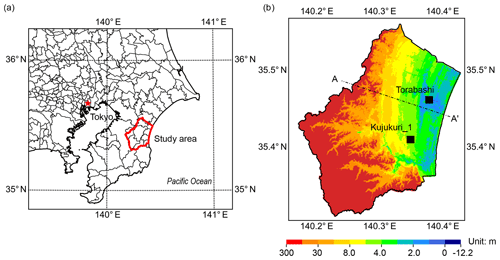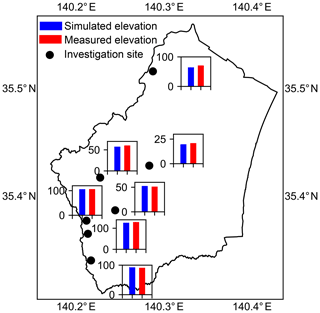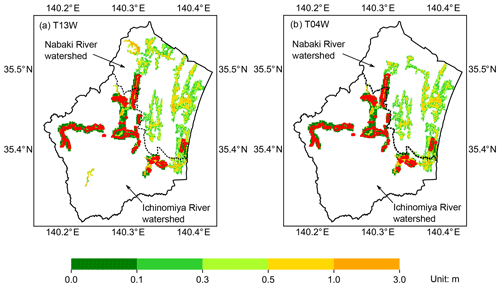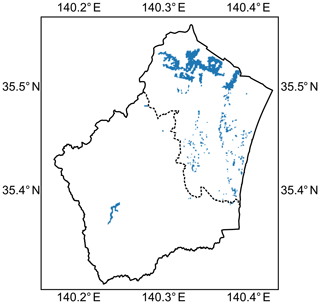Aichi, M. and Tokunaga, T.: Poroelastic modeling to assess the effect of water injection for land subsidence mitigation, Proc. IAHS, 372, 431–435, https://doi.org/10.5194/piahs-372-431-2015, 2015. a
Chen, H. L., Ito, Y., Sawamukai, M., Su, T., and Tokunaga, T.: Has land subsidence changed the flood hazard potential? A case example from the Kujukuri Plain, Chiba Prefecture, Japan, Proc. IAHS, 372, 157–161, https://doi.org/10.5194/piahs-372-157-2015, 2015. a
Chiba Prefecture: Flooding report in Chiba Prefecture, available at: http://www.pref.chiba.lg.jp/ (last access: 21 February 2020),
2013 (in Japanese). a
DHI: MIKE HYDRO River User Guide, DHI Water & Environment, Hørsholm,
Denmark, 2017a. a
DHI: MIKE SHE User Manual, Volume 1: User Guide, DHI Water & Environment,
Hørsholm, Denmark, 2017b. a
Dutta, D., Herath, S., and Musiake, K.: An application of a flood risk analysis
system for impact analysis of a flood control plan in a river basin,
Hydrol. Process, 20, 1365–1384, https://doi.org/10.1002/hyp.6092, 2006. a
Erkens, G. and Sutanudjaja, E. H.: Towards a global land subsidence map, Proc. IAHS, 372, 83–87, https://doi.org/10.5194/piahs-372-83-2015, 2015. a
Hirabayashi, Y., Mahendran, R., Koirala, S., Konoshima, L., Yamazaki, D.,
Watanabe, S., Kim, H., and Kanae, S.: Global flood risk under climate change,
Nat. Clim. Change, 3, 816–821, https://doi.org/10.1038/nclimate1911, 2013. a, b
House, A., Thompson, J., Sorensen, J., Roberts, C., and Acreman, M.: Modelling
groundwater/surface water interaction in a managed riparian chalk valley
wetland, Hydrol. Process., 30, 447–462, https://doi.org/10.1002/hyp.10625, 2015. a
Ito, Y., Chen, H., Sawamukai, M., Su, T., and Tokunaga, T.: An analysis on the relationship between land subsidence and floods at the Kujukuri Plain in Chiba Prefecture, Japan, Proc. IAHS, 372, 163–167, https://doi.org/10.5194/piahs-372-163-2015, 2015. a
Locatelli, L., Ole, M., Mikkelsen, P., Arnbjerg-Nielsen, K., Deletic, A.,
Roldin, M., and Binning, P.: Hydrologic impact of urbanization with extensive
stormwater infiltration, J. Hydrol., 544, 524–537,
https://doi.org/10.1016/j.jhydrol.2016.11.030, 2017. a
Moss, R. H., Edmonds, J. A., Hibbard, K. A., Manning, M. R., Rose, S. K., van
Vuuren, D. P., Carter, T. R., Emori, S., Kainuma, M., Kram, T., Meehl,
G. A., Mitchell, J. F. B., Nakicenovic, N., Riahi, K., Smith, S. J.,
Stouffer, R. J., Thomson, A. M., Weyant, J. P., Weyant, J. P., and Wilbanks,
T. J.: The next generation of scenarios for climate change research and
assessment, Nature, 463, 747–756, https://doi.org/10.1038/nature08823, 2010.
a
Obanawa, H., Tokunaga, T., Rokugawa, S., Deguchi, T., and Nakamura, T.: Land
subsidence at the Kujukuri Plain in Chiba Prefecture, Japan: evaluation
and monitoring environmental impacts, Proc. IAHS, 339, 293–298, 2010. a
Ozawa, S., Nishimura, T., Suito, H., Kobayashi, T., Tobita, M., and Imakiire,
T.: Coseismic and postseismic slip of the 2011 magnitude-9 Tohoku-Oki
earthquake, Nature, 475, 373–376, https://doi.org/10.1038/nature10227, 2011. a
Tamura, T., Masuda, F., Sakai, T., and Fujiwara, O.: Temporal development of
prograding beach-shoreface deposits: the Holocene of Kujukuri coastal
plain, eastern Japan, Mar. Geol., 198, 191–207,
https://doi.org/10.1016/S0025-3227(03)00123-3, 2003. a
van Vuuren, D. P., Edmonds, J., Kainuma, M., Thomson, A., Hibbard, K., Hurtt,
G. C., Kram, T., Krey, V., Lamarque, J.-F., Masui, T., Meinshausen, M.,
Nakicenovic, N., Smith, S. J., and Rose, S. K.: The representative
concentration pathways: an overview, Climate Change, 109, 5–31,
https://doi.org/10.1007/s10584-011-0148-z, 2011. a
Willner, S. N., Otto, C., and Levermannn, A.: Global economic response to river
floods, Nat. Clim. Change, 8, 594–598, https://doi.org/10.1038/s41558-018-0173-2,
2018. a
Winsemius, H. C., Van Beek, L. P. H., Jongman, B., Ward, P. J., and Bouwman, A.: A framework for global river flood risk assessments, Hydrol. Earth Syst. Sci., 17, 1871–1892, https://doi.org/10.5194/hess-17-1871-2013, 2013. a











